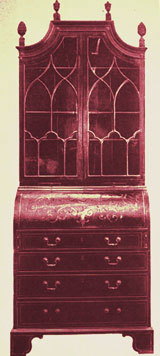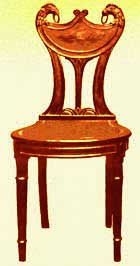Sheraton Furniture Style
Thomas Sheraton was the last of the great Georgian style furniture masters, and he created well into the 19th century. He was arguably the most artistic of al the Georgians. As all the other masters, he published his designs in works like " The Cabinet-Maker and Upholsterer's Drawing-Book," (1791), “The Cabinet Dictionary” (1803), and “Cabinet Maker, Upholsterer and General Artist's Encyclopaedia” (1805).
Historically, during the Sheraton style period in England, there were two important periods in France: Louis XVI and Empire. As a result, all the characteristics of each are found in Sheraton’s work. In his best period, the Sheraton style was unsurpassed for delicacy and grace of proportion.
He followed the French model, but he creatively added his own elements. As an example, instead of using Sèvres plaques for his commodes, he inserted compositions by Wedgwood.
Sheraton was not only an artist in design, but a master in the use of woods. He employed satinwood almost as much as mahogany, and also other exotic and native woods.

Sheraton Style Bookcase, Mahogany
He restricted the use of mahogany for chairs with carved backs, and for furniture in certain rooms like the dining-room, library, and bedroom.
The drawing-room furniture was white and gold, made of rosewood, satinwood, or wood painted and japanned. The seats of his chairs were covered with silk or satin with oval medallions or pretty stripes. He treated the cabinet, the commode and the secretary with much care, in the same time designing the most elaborate beds, draperies and dressing tables. The latter were often provided with tambour-shutters and ingenious devices for concealing mirrors and other features. His combinations of work-table and writing-table, with tambour-shutters, or bags, are marvels of compactness and convenience. He developed the cellaret sideboard, and small articles as knife-cases, dumb-waiters and supper-trays.
Sheraton used the brass ornament on a large scale: for handles, key-plates, claw-feet and rails, and also as thin lines of inlay. His preferred motifs were the lyre, the bell-flower, the festoon, the urn, and the patera, which was used to conceal the joining of chair frames and bed screws. One of his great techniques was veneering with satinwood.

Sheraton Style Hall Chair, Mahogany
Though less versatile than either Chippendale or Hepplewhite, he was artistically more correct. The Sheraton style was leaning toward the Louis XVI, while showing a strong Adam influence, through the use of straight lines and rectangular treatments. Sheraton furniture may look fragile, but is well made. A distinguishing feature is the tapering leg, usually round, and exquisitely shaped.
Form and color were his main priorities, while carving was considered a secondary matter. He was a master at inlay. Some of his finest works shows classic ornaments and borders in marquetry of sycamore, kingwood, satinwood, and green-stained whitewood set into both light and dark mahogany. The carving was always in low relief, and included such classic motifs as the urn, vase, lyre, cornucopia, wreath, and musical instruments.
The Sheraton style used sometimes the oval chair-back inspired by Adam, but the typical one was rectangular, with the top line broken. Within the frame were various forms of straight-line work, or carved motifs like the vase or urn. The shield shaped back of Hepplewhite was rarely used, while the pierced splat of Chippendale never.
Sheraton designed a wide variety of furniture, including tables, sideboards, bureaus, desks and writing-tables, sofas, and slender four-poster bedsteads.
The Sheraton style furniture was followed by the heavy, less graceful forms of the 19th century.
